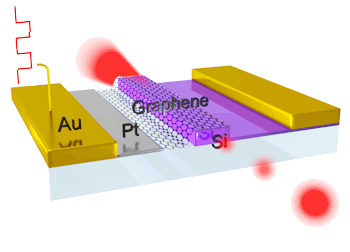Graphene-Assisted Optical Modulator
May 12, 2011
At one time, I worked with
magneto-optical materials.[1] When the properties of these materials (
Faraday rotation and thickness) were just right, you could make an
optical modulator by placing films or slabs of these materials between
polarizing filters. Application of a modulating
magnetic field would modulate light passing through such a device.
These optical modulators were not ideal. They would work well at a chosen
wavelength, but not so well for light at different wavelengths. Also, since their magnetic properties were
temperature dependent, the
modulation index would vary with temperature. You immediately threw away half your light because of the polarizing filters, and your material
absorbed an additional amount.
With all these inherent problems, you're probably surprised why
scientists would do research on these materials in the first place. There was an important application. In the days before ubiquitous and high speed computing, there was the idea that light could be used to do signal processing in
optical computers. A common optical element for this type of processing was the
spatial light modulator built from magneto-optical materials.
In a recent paper in
Nature,[2-3] scientists from the
National Science Foundation funded
Nano-scale Science and Engineering Center and related groups at the
University of California at Berkeley have described a modulator for
infrared light made from a
silicon waveguide topped with a
graphene sheet. Silicon absorbs light at wavelengths below about 950
nm, which includes the entire visible spectrum, so it appears black. Silicon, however, is quite transparent to light of wavelength longer than about 1100 nm.
The traditional structure for a silicon light modulator is the
Mach–Zehnder interferometer, which uses the
electro-optic effect in silicon to
phase-shift light in one waveguide so that it causes an
amplitude modulation when combined with unshifted light in another waveguide. Such a modulator works at just a particular wavelength of light, or multiples of that wavelength. As a consequence, its operation is temperature sensitive since the silicon properties vary with temperature. Also, since the electro-optic effect in silicon is weak, these modulators need to be large, taking a few square
millimeters of
chip space.[3]
The Berkeley team used another, more fundamental, property of optical waveguides. A waveguide contains light because the
refractive index of its material is larger than its surroundings. If the waveguide is clad with a material of a higher refractive index, light will exit the waveguide and enter the cladding material.
It was found that the
Fermi level of
electrons in graphene can be changed with applied
voltage. If a negative voltage is applied, electrons flow out of the graphene, the graphene is no longer an optical absorber, so it becomes transparent. As far as light is concerned, the graphene has disappeared.
In the Berkeley modulator, graphene clads a silicon waveguide. In its normal state, the graphene will absorb light from the waveguide. Application of the proper voltage causes the graphene to become transparent, so the waveguide light propagates without change. Modulating the voltage modulates the light.

Silicon optical waveguide using graphene as a modulating element. The graphene is shown as the network structure covering the silicon waveguide.
(Graphic by Ming Liu, UC Berkeley)
The graphene-assisted optical modulator was shown to work up to a
gigahertz in the lab, but there's no reason why it shouldn't perform at 500 gigahertz. These modulators are operable with light from 1350 - 1600 nanometers, and they require just 25 square
micrometers of chip space.[3]
The Berkeley research, led by professor
Xiang Zhang, was funded through the
Center for Scalable and Integrated Nano-Manufacturing, a part of the Nanoscale Science and Engineering Center. Additional funding was provided by the
US Department of Energy Basic Energy Science program.[3]

Color-enhanced scanning electron micrograph of a silicon optical waveguide using graphene as a modulating element.
(Image by Ming Liu, UC Berkeley)
![]()
References:
- D.M. Gualtieri and P.F. Tumelty, "Magneto-Optical Garnet Films with High Faraday Rotation and Controlled Coercivity," J. Appl. Phys., vol. 57, no. 8, (April 15, 1985), pp. 3879-3881.
- Sarah Yang, "Graphene optical modulators could lead to ultrafast communications," University of California at Berkeley Press Release, May 8, 2011.
- Ming Liu, Xiaobo Yin, Erick Ulin-Avila, Baisong Geng, Thomas Zentgraf, Long Ju, Feng Wang and Xiang Zhang, "A graphene-based broadband optical modulator," Nature, Published online May 8, 2011.
Permanent Link to this article
Linked Keywords: Faraday effect; magneto-optical; Faraday rotation; optical modulator; polarizer; polarizing filter; magnetic field; wavelength; temperature; modulation index; absorption; scientist; optical computer; spatial light modulator; Nature; National Science Foundation; Nano-scale Science and Engineering Center; University of California at Berkeley; infrared light; silicon; waveguide; graphene; nanometer; Mach–Zehnder interferometer; electro-optic effect; phase-shift; amplitude modulation; millimeter; chip; integrated circuit; refractive index; Fermi level; electron; voltage; Ming Liu; gigahertz; micrometer; Xiang Zhang; Center for Scalable and Integrated Nano-Manufacturing; US Department of Energy; Basic Energy Science.